Budapest, 12 March 2018 – As the most valuable piece of this year’s commemorative coin issuance programme, the Magyar Nemzeti Bank will issue a gold commemorative coin ‘Golden Florin of Albert’ with a face value of HUF 50,000 in normal and piedfort (four times the weight of a normal coin) sizes on 13 March 2018. A non-ferrous metal version with a face value of HUF 2,000 of the commemorative coin will also be issued. All three commemorative coins are additions to the series ‘Hungarian gold florins from the Middle Ages’ series launched in 2012. The coin was designed by Fanni Király.
|
The first piece of the series ‘Hungarian gold florins from the Middle Ages’ was the gold coin of Charles I in 2012, with the aim of providing a full picture of good quality coins in the history of medieval Hungarian money history, which preserved their value and were widely accepted by foreign merchants as well. To be true to history, the first piece of the series was followed by the golden florin of Louis I in 2013, Queen Mary in 2014, and Sigismund in 2016. The MNB will present the Golden florin of Albert commemorative coin, to be issued as the fifth piece in the series, in Sopron, at the official opening ceremony of ‘From denarius to forint – history of the Hungarian currency’, a travelling exhibition to be organised in cooperation of the Magyar Nemzeti Bank and the University of Sopron. The Golden florin of Albert commemorative coins are legal tender in Hungary, but they do not serve circulatory purposes. Primarily they are a means to educate and raise awareness of the values of Hungarian money history, the historic predecessors of our national currency, the golden florins. The gold and the non-ferrous metal versions have the same design, the only difference being their value numerals. The central motif on the front side of the commemorative coin was inspired by the representation of the coat of arms on the obverse of Albert’s second gold florin minted from 1439, which is surrounded by master marks. On the obverse of the mint from the Middle Ages, there is a four-part escutcheon in a circle of beads, the Hungarian stripes, the Czech lion, the Austrian fess and the Moravian eagle inside refer to Albert’s regal titles. The coat of arms is surrounded by a selection of mint and master marks from the reverse sides of gold coins at the time. These marks (clockwise) refer to the following towns and persons: P – Konrád Polner, a lord of the chamber from Körmöcbánya, S – unknown person or minting location, lamb – János Lemmel a lord of the chamber from Szeben, the ligature PR – Miklós Pfeffersach a lord of the chamber from Szeben, and the letter R with a cross – Konrád Rudel a lord of the chamber from Körmöcbánya. The compulsory design elements are placed on the obverse in the outer ring: the lettering ‘MAGYARORSZÁG’ in the upper legend, the value numerals 50000 and 2000 FORINT in the lower legend, on the horizontal central axis, to the left, the mint mark ‘BP.’, and the mint year 2018 to the right. The outer ring structure also appears on the reverse of the coins. Here, the path of the lettering ‘ALBERT 1437–1439 ARANYFORINTJA’ is broken by a lozenge-shaped decorative motif on the left, and on the right, by Fanni Király’s master mark, who designed the commemorative coin. The main motif on the reverse is the realistic copy of the design structure of the reverse side of the first golden florin issued by Albert: Saint Ladislaus’s standing figure facing front, holding an axe in his right hand while a globus cruciger in the left, on the two sides a combination of the h–lamb, a mint and a master mark, is shown. The first of these marks represents the initial in the German name of Szeben (Hermannstadt), where the mint was located, while the lamb is János Lemmel’s coat of arms, the lord of the chambers who was in charge of minting. |
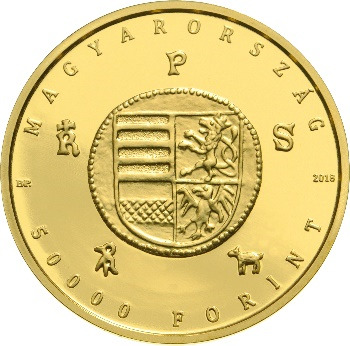 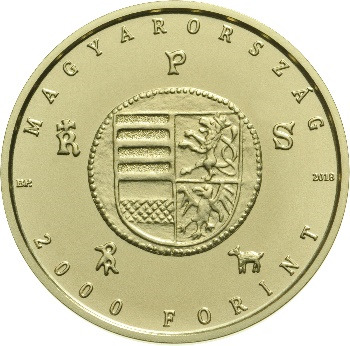 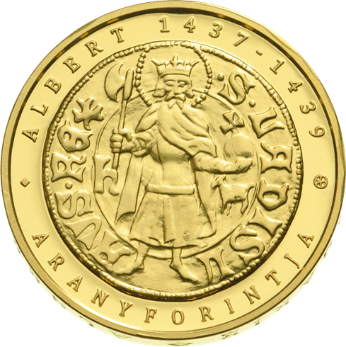 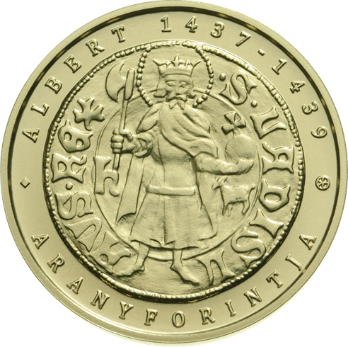 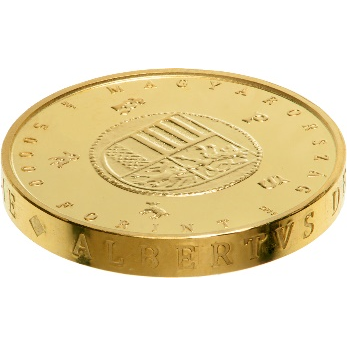 |
The gold coin with a face value of HUF 50,000 is struck in .986 fine gold. The normal coin weighs 3.491 grams (1 ducat) and the piedfort coin weighs 13.964 grams (4 ducats). The non-ferrous metal coin with a face value of HUF 2,000 is produced from an alloy of copper (75%), nickel (4%) zinc (21%) and weighs 2.7 grams. The edge of the normal gold and the non-ferrous metal coins is smooth. The piedfort version is decorated with the Latin inscription ‘ALBERTVS DEI GRATIA REX VNGARIE’ on the edge, meaning ‘Albert, king of Hungary by the grace of God’. All three coins have the same diameter of 20 mm.
From 2014, all collector coins produced from precious metals will also be issued in low-cost versions made from non-ferrous metals. To facilitate the enforcement of the coins' value transferring and educational role as widely as possible the non-ferrous metal commemorative coin with a face value of HUF 2000 can be purchased without time constraint, subject to availability, at the face value from 13 March 2018 at the coin shop of Hungarian Mint Ltd. (Budapest, distr. V, 7 Báthory street) and in the webshop on the company’s website (http://www.penzvero.hu/).
The mintage limit of the standard size collector coin is 2,000 and that of the piedfort coin is 500 in proof finish. The mintage limit of the non-ferrous metal coin is 5000 in BU finish.